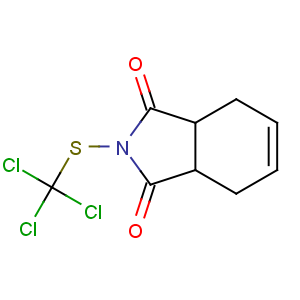References of 2-(trichloromethylsulfanyl)-3a,4,7,7a-tetrahydroisoindole-1,3-dione
Title: Captan
CAS Registry Number: 133-06-2
CAS Name: 3a,4,7,7a-Tetrahydro-2-[(trichloromethyl)thio]-1
H-isoindole-1,3(2
H)-dione
Synonyms: N-(trichloromethylthio)-4-cyclohexene-1,2-dicarboximide;
N-trichloromethylthio-3a,4,7,7a-tetrahydrophthalimide;
N-trichloromethylmercapto-4-cyclohexene-1,2-dicarboximide;
N-(trichloromethylmercapto)-D4-tetrahydrophthalimide
Manufacturers' Codes: ENT-26538; SR-406
Trademarks: Merpan; Orthocide-406; Vancide 89
Molecular Formula: C9H8Cl3NO2S
Molecular Weight: 300.59
Percent Composition: C 35.96%, H 2.68%, Cl 35.38%, N 4.66%, O 10.65%, S 10.67%
Literature References: Prepn: A. R. Kittleson,
US 2553771;
US 2653155;
US 2713058 (1951, 1953, 1955 all to Standard Oil);
idem, Science 115, 84 (1952);
idem, J. Agric. Food Chem. 1, 677 (1953). Colorimetric determination: A. R. Kittleson,
Anal. Chem. 24, 1173 (1952). Review of mutagenicity studies: B. A. Bridges,
Mutat. Res. 32, 3 (1975); of carcinogenic risk:
IARC Monographs 30, 295-318 (1983).
Properties: Odorless crystals from CCl4, mp 178°. d 1.74. Practically insol in water. Soly at 26° in g/100 ml: chloroform 7.78; tetrachloroethane 8.15; cyclohexanone 4.96; dioxane 4.70; benzene 2.13; toluene 0.69; heptane 0.04; ethanol 0.29; ether 0.25. LD50 orally in rats: 9000 mg/kg (Bridges).
Melting point: mp 178°
Density: d 1.74
Toxicity data: LD50 orally in rats: 9000 mg/kg (Bridges)
CAUTION: Potential symptoms of overexposure are irritation of eyes, skin, upper respiratory system; blurred vision; dermatitis, skin sensitization; dyspnea; diarrhea, vomiting. Potential occupational carcinogen.
See NIOSH Pocket Guide to Chemical Hazards (DHHS/NIOSH 97-140, 1997) p 50.
Use: Fungicide; bacteriostat in soap.

